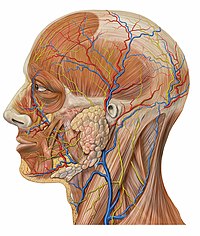
Photo from wikipedia
PurposeLocalization of the facial nerve trunk (FNT) [i.e., the portion of the facial nerve between the stylomastoid foramen (SMF) and pes anserinus] may be required during various surgical interventions such… Click to show full abstract
PurposeLocalization of the facial nerve trunk (FNT) [i.e., the portion of the facial nerve between the stylomastoid foramen (SMF) and pes anserinus] may be required during various surgical interventions such as parotidectomy and hypoglossal-facial anastomosis. Several landmarks have been proposed for efficient identification of the FNT. We sought to assess the anatomical features of the digastric branch of the facial nerve (DBFN) and its potential as a landmark to identify FNT.MethodsFifteen sides of eight cadaveric heads were dissected to find the DBFN. Anatomic features of DBFN including its point of origin relative to SMF, length, and important relationships, as well as the distance between the insertion point on the digastric muscle and mastoid tip were recorded.ResultsDBFN was found in all specimens originating from the FNT outside the SMF with an average length (± standard deviation) of 15.4 ± 3.4 mm. In all specimens, the DBFN inserted on the superomedial aspect of the posterior belly of the digastric muscle (PBD). In 8/15 specimens, DBFN was accompanied by the stylomastoid artery on its anteromedial side. Average distance (± standard deviation) between the mastoid tip and the nerve insertion point on PBD was 13.6 ± 2.0 mm (range 10–17).ConclusionsThe DBFN is a reliable landmark for identifying the FNT. It could be consistently identified within 15–20 mm of the mastoid tip on the superomedial aspect of the PBD. The DBFN may be used as a supplementary landmark for efficient localization of the FNT.Level of evidenceNot applicable (anatomic study).
Journal Title: Surgical and Radiologic Anatomy
Year Published: 2019
Link to full text (if available)
Share on Social Media: Sign Up to like & get
recommendations!